- Why is Litchi not connecting to my DJI drone?
- Why is Litchi not connecting to my Phantom 2 Vision/Phantom 2 Vision ?
- . I purchased the app on one device, can I install it on other devices?
- . I won’t have Internet access where I want to fly, will I still be able to see the maps?
- Autonomous flights (Waypoint, Orbit, Follow, etc) fail to start, why?
- My Waypoint/Follow/Orbit flights fail to start, why?
- How to regain control of my aircraft during an autonomous flight when using a remote controller?
- How to regain control of my aircraft during an autonomous flight?
- Will the aircraft avoid obstacles if there are any?
- Which firmware version do I need to use Litchi?
- Is my Android device supported by Litchi?
- Is there an iOS version?
- What is the difference between Litchi for Android and Litchi for iOS?
- I purchased the app on one device, can I install it on other devices?
- Aircraft
- Aircraft head tracking
- Android
- Auto pano
- Bluetooth controllers
- Camera
- Camera focus
- Camera settings
- Camera zoom
- Digital elevation model files
- Drawing tool
- Elevation data
- Exposure metering
- Focus
- Follow
- Follow settings
- General
- Gimbal roll adjustment
- Ground station / waypoints
- Litchi vue streaming
- Loading / saving a mission
- Mobile device camera
- Online elevation
- Orbit
- Orbit settings
- Panorama
- Panorama database (ios only)
- Pausing a mission
- Point of interests
- Regaining control
- Running a mission
- Running a track session
- Settings
- Simulator mode
- Status bar
- Stitching a panorama outside of litchi
- Stopping a mission
- Stopping focus
- Stopping follow
- Stopping orbit
- Stopping panorama
- Stopping track
- Track
- Virtual reality
- Visual mission planning with google earth
- Waypoint
- Waypoint actions
- Waypoint gimbal pitch
- Waypoint settings
- Waypoints
- Приложения для дронов: litchi
- Примечания по особенностям работы с приложением litchi
Why is Litchi not connecting to my DJI drone?
Please refer to the General tab section “Connecting Litchi to your drone”.
Why is Litchi not connecting to my Phantom 2 Vision/Phantom 2 Vision ?
When starting the app for the first time, you will need to be connected to Internet in order to validate the app with DJI servers.Some Internet connections may have troubles connecting to DJI servers, in such a case make sure to try a different Internet connection.
. I purchased the app on one device, can I install it on other devices?
You can install the app on as many devices as you want as long as they use the same platform and the same “main” account (Google, Apple or Amazon) that was used for the original purchase. If you wish to use Litchi on two or more platforms you will need to purchase it on each one.
. I won’t have Internet access where I want to fly, will I still be able to see the maps?
If you cache the maps prior to the flight, you will be able to see them even when offline. To cache maps while connected to Internet, drag the map around where you are planning to fly, zoom in and zoom out. You can exit Litchi in between but avoid restarting the mobile device as it may clear the cache.
Autonomous flights (Waypoint, Orbit, Follow, etc) fail to start, why?
The flight mode should be P-mode (F for older drones) in order for the aircraft to perform autonomous flights. If the problem persists, double check that you are using the latest supported firmware.
My Waypoint/Follow/Orbit flights fail to start, why?
Double check that you are using the latest supported firmware.
How to regain control of my aircraft during an autonomous flight when using a remote controller?
Change the flight mode to Sport (P for older drones). The aircraft will then stop the autonomous flight and you will regain control instantly.
How to regain control of my aircraft during an autonomous flight?
Flip the remote controller mode switch from the top position to the middle position and then back to top position straight away. The aircraft will then stop the autonomous flight and you will regain control instantly.
Will the aircraft avoid obstacles if there are any?
For the Mavic/Phantom 4/Inspire 2/Spark obstacle avoidance will work when it is available and enabled. For all other aircrafts, obstacles will not be avoided.
Which firmware version do I need to use Litchi?
The latest public firmware.
Is my Android device supported by Litchi?
As a general rule, Litchi supports most mid to high-end Android devices. There are many Android devices and versions out there, and even two similar devices can yield very different results, for this reason there is no list of supported devices.
The best way to find out if your device is supported by Litchi is to purchase the application and give it a try.
Is there an iOS version?
We have no iOS plans for the P2 vision series.
What is the difference between Litchi for Android and Litchi for iOS?
Litchi Magic Leash is currently only supported on Android. Litchi Vue streaming and in-app Pano stitching are currently only supported on iOS.
I purchased the app on one device, can I install it on other devices?
You can install the app on as many devices as you want as long as they use the same google account that was used for the original purchase.
Aircraft
- Go Home Altitude: Use this to set the altitude that the aircraft will return at when Return to Home is triggered.
- Maximum Altitude: Sets the maximum flight altitude.
- Dynamic Homepoint: When enabled, the home point will continuously be updated to the current location of your mobile device. Recommended in Follow mode.
- Log Flights: Enable/disable flight logs. Flight logs are saved in the mobile device’s internal storage in the “LitchiApp/flightlogs” folder. Android only – on iOS flight logs cannot be disabled.
- Airdata UAV User Token: Enter the token from your https://airdata.com/ account here. Your token should look like this: HD12345678. This token is a secure way to associate your flight logs with your account when they are uploaded to Airdata UAV.
InfoClick here to learn more about how to setup Airdata UAV with Litchi. - Airdata UAV Automatic Sync: When enabled, and if your user token is valid, your flight logs will be automatically synced with your Airdata UAV account given the presence of an Internet connection.
- Sync Photo/Video Previews: Photo preview screenshots and video preview screenshots will be automatically taken by Litchi during flights. Using this setting, you can allow Litchi to automatically sync up to 4 or 10 photo/video previews per flight log to your Airdata UAV account. Android only.
Warning This setting may increase the data usage of the app significantly. - Sync with Airdata UAV Now: Use this button to manually trigger a sync of your flight logs with your Airdata UAV account.
- Signal Lost Behavior: This defines the behavior of the aircraft if signal is lost; choose between “Hover”, “Landing” or “Return To Home”.
- Exit Waypoint Mission on Signal Loss: When enabled, waypoint missions will end when signal is lost. When that happens, the drone will then execute the failsafe procedure (which can be changed with the “Signal Lost Behavior” setting). This setting cannot be changed for newer DJI drones (Mavic Mini 1, Mavic Air 2) as they are not able to continue waypoint missions beyond signal range.
- Smart Return to Home: Enables/disables the Smart Return-To-Home (RTH) feature. When it is enabled, aircraft will request to go home when remaining battery is only enough for completing the go-home action.
- Collision Avoidance: Enables/disables collision avoidance. Mavic/Phantom 4/Inspire 2/Spark only.
- Active Obstacle Avoidance: Enables/disables active obstacle avoidance. When enabled, and an obstacle is moving towards the aircraft, the aircraft will actively fly away from it. If while actively avoiding a moving obstacle, the aircraft detects another obstacle in its avoidance path, it will stop. Collision Avoidance must also be enabled. Mavic/Phantom 4 (Advanced/Pro/ProV2)/Inspire 2/Spark only. iOS only.
- Advanced Pilot Assistance System (APAS): Enables/disables DJI’s Advanced Pilot Asistance System. Supported drones only.
- Landing Protection: Enables/disables landing protection. During auto-landing, the downward facing vision sensor will check if the ground surface is flat enough for a safe landing. If it is not and landing protection is enabled, then landing will abort and need to be manually performed by the user. Mavic/Phantom 4/Inspire 2 only.
- Precision Landing: Enables/disables precision landing. When enabled, the aircraft will record its take-off location visually (as well as with GPS). On a Return-To-Home action the aircraft will attempt to perform a precision landing using the additional visual information. This method only works on a Return-To-Home action when the home location is successfully recorded during take-off, and not changed during flight. Mavic/Phantom 4 only.
- Vision Positioning System: Enables/disables the vision positioning system. Mavic/Phantom 4/Inspire 2/Spark only.
- Front Aircraft LEDs: Switches the aircraft’s front LEDs on or off.
- Bottom Light: Switches between Auto/On/Off for the bottom light when present.
- Calibrate Compass: Tap to start calibration procedure. The aircraft LEDs will turn solid yellow and you can then start the “calibration dance”.
- Maximum Location Accuracy: This setting defines the maximum location accuracy required for Follow mode to work. If the mobile device GPS shows a higher accuracy than this value, Follow sessions will fail to start. Additionally, if during a Follow session the mobile device GPS accuracy jumps to a value that is higher than this setting, the aircraft will stop moving until the accuracy comes back to a healthy level. As a result, it is important to set this value correctly. It defaults to 15 meters, but if you are having issues with GPS accuracy and depending on your environment, you may want to increase the default value.
- Gimbal mode: Switch between the FPV mode, Yaw Follow mode (default) and Free (Inspire series only). In FPV mode, the gimbal’s roll will mirror the right joystick’s movements (left/right, mode 2).
- Gimbal Gesture Control: When enabled, tap the video screen and scroll up or down (as well as left/right for the Inspire 1-2) to move the gimbal.
- Gimbal Extension ( 30°): When enabled, the gimbal’s maximum pitch angle is extended to 30° above horizon, instead of the default 0°. Not applicable for Spark.
- Lock Gimbal when Shooting Photos: Enables this to lock the gimbal when the camera is shooting a photo. The gimbal will keep the attitude when starting to shoot the photo.
- Gimbal Endpoint Auto Release: When enabled, the Inspire 2 will automatically rotate when the gimbal reaches the yaw angle limit. Inspire 2/iOS only.
- Sync Gimbal Yaw with Aircraft Heading: Enables this to make the gimbal rotate simultaneously with the aircraft’s heading when you control the aircraft’s heading with the remote controller.
- Preview Quality: For Lightbridge-based drones only (P3/P4/I1/I2). Select the quality of the video stream from 4/6/8/10 Mbps or Auto. When set to Auto, both the channel and preview quality will be selected automatically.
- Transmission Channel: For Lightbridge-based and WiFi drones (Spark/Mavic Air/P3/P4/I1/I2). Select a specific transmission channel or Auto. When set to Auto, both the channel and preview quality will be selected automatically.
- Ocusync Preview Quality: For Ocusync-based drones only. Select the channel bandwidth between 10MHz and 20MHz or Auto. On Auto, both the channel and preview quality will be selected automatically.
- Ocusync Transmission Channel: For Ocusync-based drones only. Select a transmission channel or Auto. On Auto, both the channel and preview quality will be selected automatically.
- Double Output (HDMI): Enable to have the video stream output to the HDMI module in addition to the app.
- Display Secondary Video Feed: Enables showing the secondary video feed. Only for drones which have more than one camera.
- Primary Video Feed Source: Select which camera will be the primary video feed. Only for drones which have more than one camera. Android only.
- Secondary Video Feed Source: Select which camera will be the secondary video feed. Only for drones which have more than one camera. Android only.
- Lightbridge 2 Video Source: For Lightbridge 2 drones only. Select the video source that will be displayed in the app.
- Frequency Band: Sets the frequency band. It is only supported by Inspire 2, Phantom 4 Pro, Phantom 4 Pro V2 and Mavic 2 Zoom/Pro.
Aircraft head tracking
In Joystick mode, rotating your head left/right is similar to using the left joystick’s left/right axis (mode 2). As an example, the more you rotate your head to the left, the faster the aircraft will rotate to the left.
The zero point, at which the aircraft will not rotate, is set when VR mode starts using the current mobile device orientation at that time.
Android
For remote controllers with a USB connection (Mavic, Phantom 3 Adv/Pro, Phantom 4, Inspire), follow these steps:
Auto pano
Auto Pano uses preset parameters to shoot a 360° spherical panorama.
In addition, Litchi will use optimized camera settings and panorama settings to improve the chances of a successful stitch in Litchi’s Panorama Database (iOS only).
Info If you use a camera which has variable focus, make sure to set the focus before starting the Auto Pano.
Bluetooth controllers
Litchi allows you to control Wi-Fi based drones (Spark, Phantom 3 Standard, Mavic Air/Pro) with a bluetooth controller when no DJI remote controller is connected.
If you are looking for a compatible bluetooth controller, we recommend the Mad Catz CTRL i for iOS.
Litchi will automatically recognize and accept input from a bluetooth controller after it is paired with your mobile device.
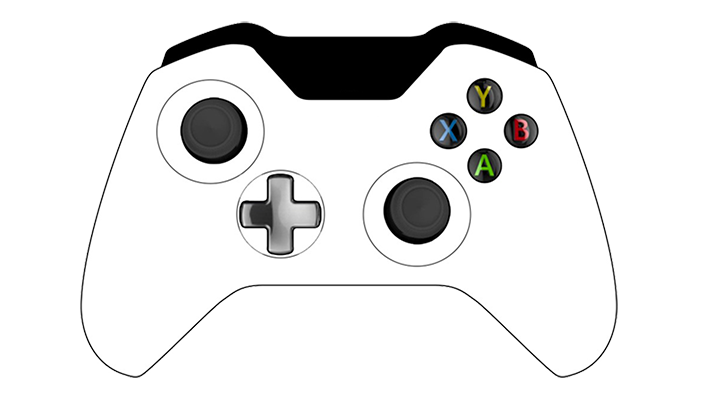
- Left and Right Joysticks: Used to control the drone the same way you would control a drone with a DJI remote controller in mode 2.
- A: Take a photo.
- X: Start/Stop recording.
- B: Triggers the custom function bound to C1.
- Y: Triggers the custom function bound to C2.
- Directional Pad – Y axis: Moves the gimbal up/down.
Camera
- Auto Record: Enable/disable Auto recording. Auto record starts/stops when motors start/stop.
- Photo Quality When Recording: Choose between “Screengrabs (Instant)” and “High Resolution (JPEG)”. While recording, and if set to “Screengrabs” taking a picture will in fact take a screen grab of the video being recorded. This has the benefit of being instant and will not stop the recording, on the other hand the resolution maxes out at 1080p. The second option, “High Resolution” means that if you try to take a photo while recording, the app will stop recording, take a photo and restart recording, the result is a much higher quality picture at the cost of a recording interruption.
- Auto Boost FPV: When enabled, the aircraft camera signal will automatically be boosted when motors start.
- FPV Boost Power: The power value that the camera signal will be set to. Higher means better range, but it also means increased chances of overheating. 13dB is a good compromise.
- Show Camera Controls: Show/hide camera controls.
- Grid Lines: Show/hide grid lines on the video screen, useful to help framing a shot.
- Preview Quality: Select the quality of the video stream. 640×480 15 fps or lower is recommended.
- Camera Action When Connection Is Broken: Select the action you want the camera to perform when the connection is lost.
- Reset Camera Settings: Tap to reset the camera settings. A restart of the aircraft is required to fully reset the camera settings.
- Format SD Card: Tap to format the SD Card.
Camera focus
For cameras with adjustable focus, the camera focus mode can be changed in the camera settings. Available modes are Auto, AFC and Manual.
To set the focus on a specific location, make sure you are in Auto or AFC focus mode then tap anywhere on the video preview to trigger autofocus at that location.
To set the focus to Infinity (everything in focus)
, switch to Manual focus mode then tap on the Infinity (∞) button. Alternatively you can use the custom function “Focus to Infinity”. Before using Infinity focus for the first time, it is recommended to calibrate the lens. Tap on “Calibrate Lens” in the camera settings then follow the steps on-screen.
Camera settings
General camera settings as well as shooting modes (Single/HDR/Burst/AEB/Interval) can be adjusted after a tap on the camera settings icon under the shutter/record button.
An exposure info panel is also shown at the top of the video screen when connected to the aircraft.
To set the ISO/Shutter Speed/Aperture/Exposure Compensation, tap on the Camera Settings button, then “Exposure Settings”.
Camera zoom
Optical zoom: For cameras which support optical zoom but cannot be adjusted using the RC’s right wheel: hold the RC’s C2 button and use the left RC wheel to adjust the focal length.
Custom Function:
Digital elevation model files
Elevation Data can be provided using a Digital Elevation Model (DEM) file.
To import a DEM, go to “Missions” then “Import DEM”, then select the DEM file on your computer. Mission Hub supports Esri ASCII Grid format (.asc files)
Drawing tool
The drawing tool allows you to quickly setup a waypoints mission, simply draw the path you want the aircraft to follow.
To enter the drawing mode, tap the pencil icon located in the top right corner of the map. Then, draw the mission path on the map.
When you are done, lift your finger from the screen and a Batch waypoint settings window will appear, use it to set global settings for the waypoints that will be created from the drawn path.
In this window, you will find an additional setting, the “Waypoint Spacing” which is the minimum distance between the waypoints that will form the drawn path.
Elevation data
In order to use the “Above Ground” option to set altitudes, Mission Hub needs to know the ground elevation. There are two possible sources for Elevation Data.
Exposure metering
By default exposure metering is in Average mode. If your camera supports adjustable focus, you can set the exposure metering to Spot mode by following these steps:
- Do a long press on the green square icon at the top left of the video preview to switch to Metering mode.
- Tap anywhere on the video preview to set Spot metering at that location.
To go back to Average metering mode, tap again on the Spot metering icon and the icon will disappear.
Focus
Focus allows you to easily keep a subject (Point of Interest or Mobile Device) in the video frame while flying the aircraft manually.
The aircraft rotation (yaw) and gimbal pitch angle are controlled by Litchi as well as the gimbal yaw for Inspire 1-2.
Focus is compatible with Litchi Magic Leash (Android only), making it possible to focus on an external mobile device.
Enter the Focus mode by pressing the Flight Mode icon at the top left of the Litchi screen. Select “Focus”.
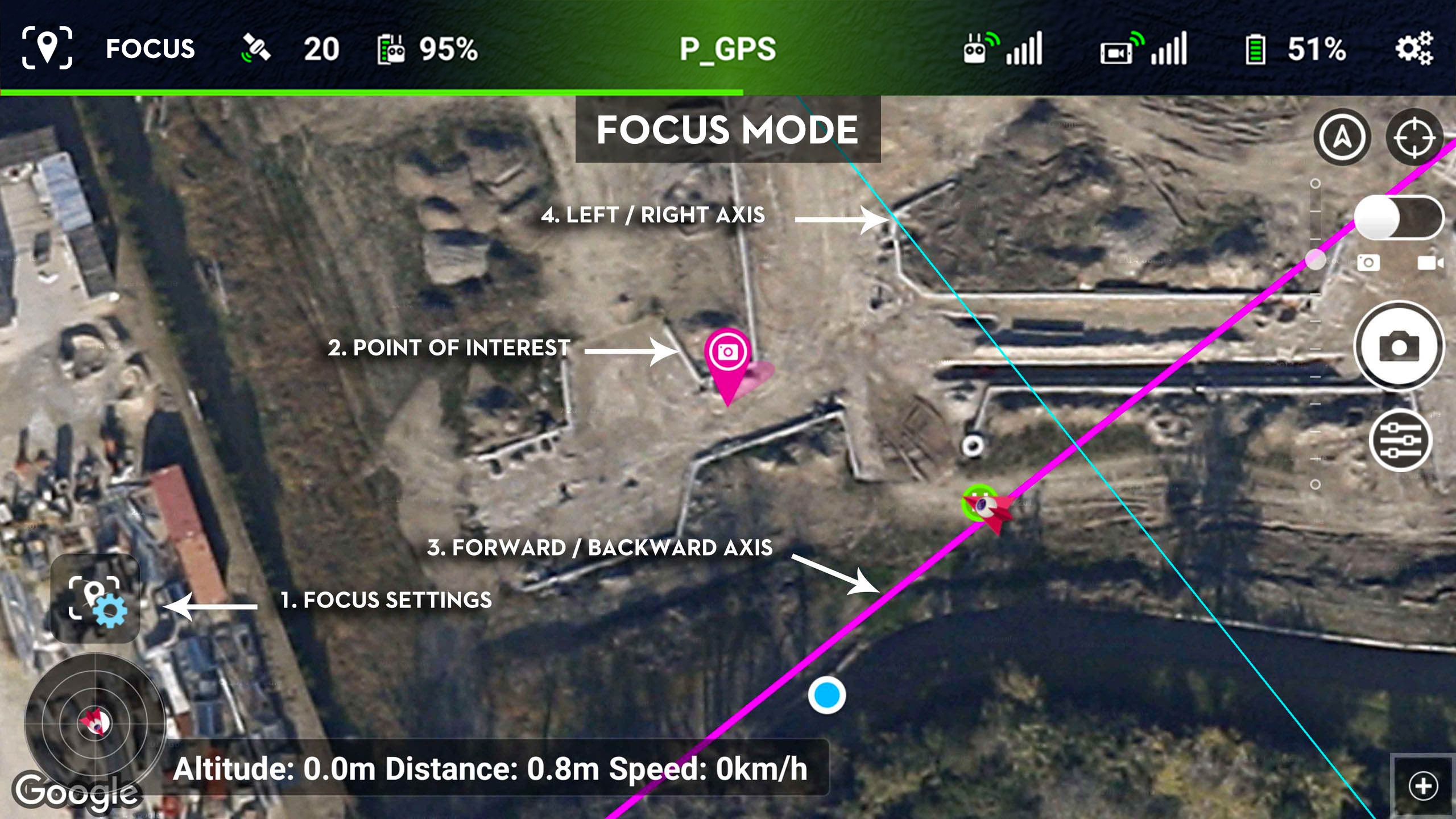
- Focus Settings: Tap to bring up the Focus settings window (details below).
- Point of Interest: The point of interest marker.
- Forward/Backward Axis: Represents the “Joystick Reference” pitch axis along which the aircraft course is locked. Shown when “Aircraft Rotation” is enabled and a custom “Joystick Reference” is selected.
- Left/Right Axis: Represents the “Joystick Reference” roll axis along which the aircraft course is locked. Shown when “Aircraft Rotation” is enabled and a custom “Joystick Reference” is selected.
Follow
Follow causes the aircraft to follow the movements a subject.
The subject is usually the mobile device that is connected to the drone but it can also follow a pin on a map.
The maximum aircraft speed in this mode is 4.2m/s (no wind).
Warning It is advisable to only use the Follow feature in wide open areas.
Enter the Follow mode by pressing the Flight Mode icon at the top left of the Litchi screen. Select “Follow”. Press the Follow Settings icon on the left side of the screen.

- Mobile Device GPS Accuracy: The estimated accuracy of your mobile device’s location, in meters/feet.
If you draw a circle centered at your mobile device’s location, and with a radius equal to the accuracy, then there is a 68% probability that
the true mobile device’s location is inside the circle. If this number is red, it means your current location accuracy is over the minimum location accuracy general setting. In such a case, you will not be allowed to start Follow. If you are having difficulties getting a good location accuracy, try another area, try another mobile device, or increase the “Location Accuracy” general setting. Setting the “Location Accuracy” to a higher value will allow for a bigger margin of error for the mobile device GPS signal, but the follow me movements may be less precise. - Follow Touch Mode: Tap to toggle the Follow Touch mode. In this mode, the aircraft will follow the Touch mode marker instead of the mobile device.
- Follow Settings: Tap to display the follow settings (more details below).
- Touch Mode Marker: When the Follow Touch Mode is enabled, tap anywhere on the map to set this marker, which the aircraft will follow. The marker is also draggable.
Follow settings
For Follow to work, the app needs to know the position of the subject in relation to the aircraft. The easiest way to set these relative values is to fly the aircraft at the relative position the aircraft should be in when the subject begins to move, and press the “Set from Aircraft Position.”
All settings except “Altitude Reference” can be altered in real-time.
General
- Units: Use to switch between Metric or Imperial units.
- Map Engine: Use to switch the map engine used by Litchi.
- Map Type: Use to switch between Standard (no imagery), Satellite (imagery), Terrain (topographic) and Hybrid (imagery street names).
- Map Auto Zoom: Enable/disable map auto zoom.
- Map Safe Area Radius: When not 0, a red circle will be drawn on the map to represent a safe distance area. This is only a visual help and will not limit you in any way should you wish to go out of the bounds of this circle. Android only.
- Show GEO Warning Zones: Show/hide GEO Enhanced Warning and Warning zones on the map. iOS only.
- Use Amap Imagery (for China Mainland): To be used in conjunction with the “Calibrate Map for China Mainland” setting. When the map is calibrated, Google’s imagery will not map to their true location, enable this setting to fix it. iOS only.
- Calibrate Map for China Mainland: If you are in mainland China, enable this setting to get correct GPS coordinates on the map. iOS only.
- Show Home Orientation: When enabled shows a line between the home point and the aircraft on the map.
- Show GPS Coordinates: When enabled, shows the current latitude and longitude of the aircraft next to the altitude, distance and speed indicators at the bottom left of the screen. In addition, when enabled this setting allows you to edit waypoint coordinates in Waypoint mode.
- Show VPS Height when Used: When this setting is enabled and when the Visual Positioning System is active (5m or less above the ground), the more precise ultrasonic height will be shown instead of the barometric altitude.
- Show Battery Voltage: When enabled, shows the lowest aircraft battery cell voltage under the battery percentage.
- Language: Changes the language of the application. Requires a restart.
- Find My Aircraft: Tap to enter a map screen which will display the last known location of your aircraft.
- Help: Tap to view this help page. Requires an Internet connection to access the first time. After that, it will be cached for offline use.
- Reset All Settings: Tap to reset all settings. Requires a restart.
Gimbal roll adjustment
To adjust the gimbal’s roll angle, hold the RC’s C2 button and use the right RC wheel.
Ground station / waypoints
Litchi’s Ground Station mode allows you to setup waypoint missions.
Place multiple waypoints on a map however far you want and the aircraft will fly from waypoint to waypoint and complete the mission even if the signal is lost.
On Android, to enter the Ground Station, press the Flight Mode icon at the top left of the Litchi screen. Select “GS”. You can then start editing missions.

- Go Home: Tap to trigger Return to Home.
- Start/Pause/Resume Mission: In edit mode, tap this button to show the pre-flight report and then start the mission. While in a mission, this button will allow you to pause and resume the waypoint mission.
- Save Mission: Tap this button to save a mission.
- Load Mission: Tap this button to load a previously saved mission.
- Drawing Tool: Toggles the drawing tool. When on, you will be able to draw a path of waypoints on the map.
- Clear All: Tap to reset everything in the editor.
- Mission Info: Shows general mission information. In edit mode, the total distance and time will be shown. During a mission, the “target” waypoint number will be shown.
Litchi vue streaming
Platforms Litchi Vue is only available on iOS at this time.
Litchi Vue allows streaming the drone video from the pilot’s mobile device to a second mobile device using a Wi-Fi connection. This feature has a trial version that lets you stream for up to 20 minutes, and can be purchased to unlock unlimited streaming.
The following video explains how to use Litchi Vue:
Warning
Bluetooth must be turned off on at least one of the 2 devices before using Litchi Vue.
Follow these steps to setup Litchi Vue:
Loading / saving a mission
Missions can be planned anywhere, you do not need to be connected to the aircraft in order to plan a mission.
To save a mission, tap the save button in the left button bar. Enter a filename, click Ok and the mission will then be saved in the “LitchiApp/missions” (“missions” on iOS) folder located in the mobile device’s internal storage.
To load a mission, tap the load button in the left button bar, select the mission then click load.
When logged in to your Litchi account, missions will be synced automatically across all of your devices as well as on the Mission Hub.
By default, missions sync’ed in your account will be private and not visible to anyone unless you set them to public in the Mission Hub.
Mobile device camera
For remote controllers with C1/C2 custom buttons (all aircrafts except P3 Standard), you can bind the custom function “Toggle Mobile Device Camera (VR)” to either C1 or C2.
This allows you to switch between your drone’s camera view and your mobile device’s camera view, making it very easy to keep track of your surroundings with the goggles on.
Online elevation
Orbit
Orbit causes the aircraft to circle around a point of interest while optionally having the gimbal keeping focus on it.
The orbit parameters (radius, altitude, speed) can be altered in real-time.
Enter the Orbit mode by pressing the Flight Mode icon at the top left of the Litchi screen. Select “Orbit”.
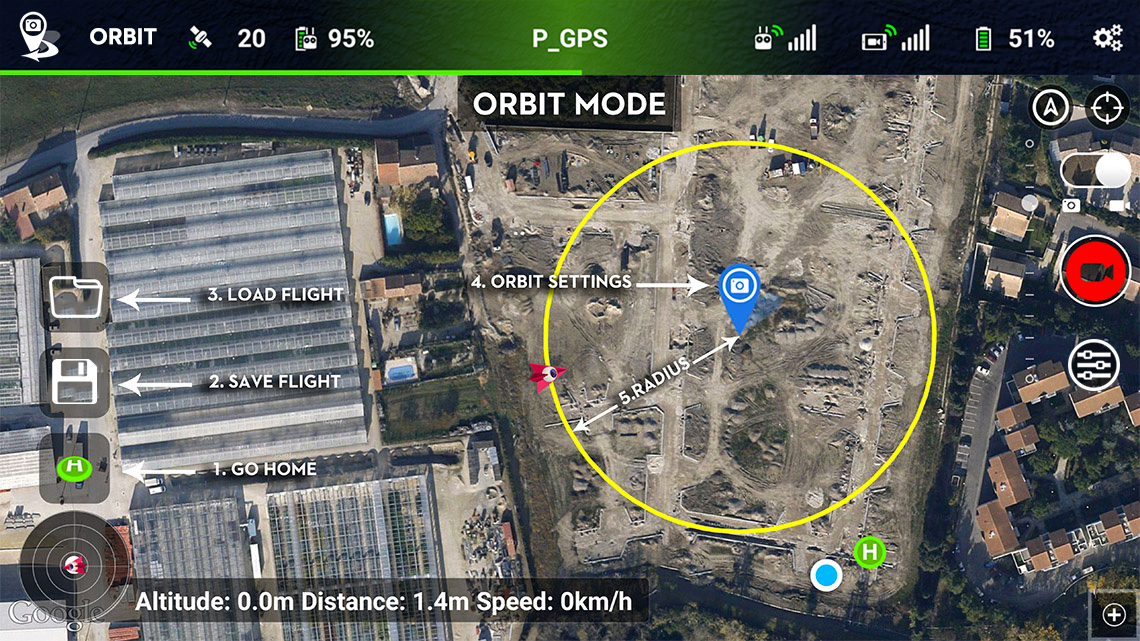
- Go Home (Android only): Tap to initiate Return to Home at any time. Return to Home can also be triggered using the remote controller.
- Save Flight: Tap to save the current Orbit parameters.
- Load Flight: Tap to load a previously saved Orbit flight.
- Orbit Settings: Tap the point of interest marker to bring up the Orbit settings window (details below).
- Radius: The orbit circle is displayed on the map with a yellow line. It is updated in real-time if you change it during an Orbit session.
Orbit settings
To bring up the Orbit settings window, place a point of interest marker on the map, then tap on it.
Panorama
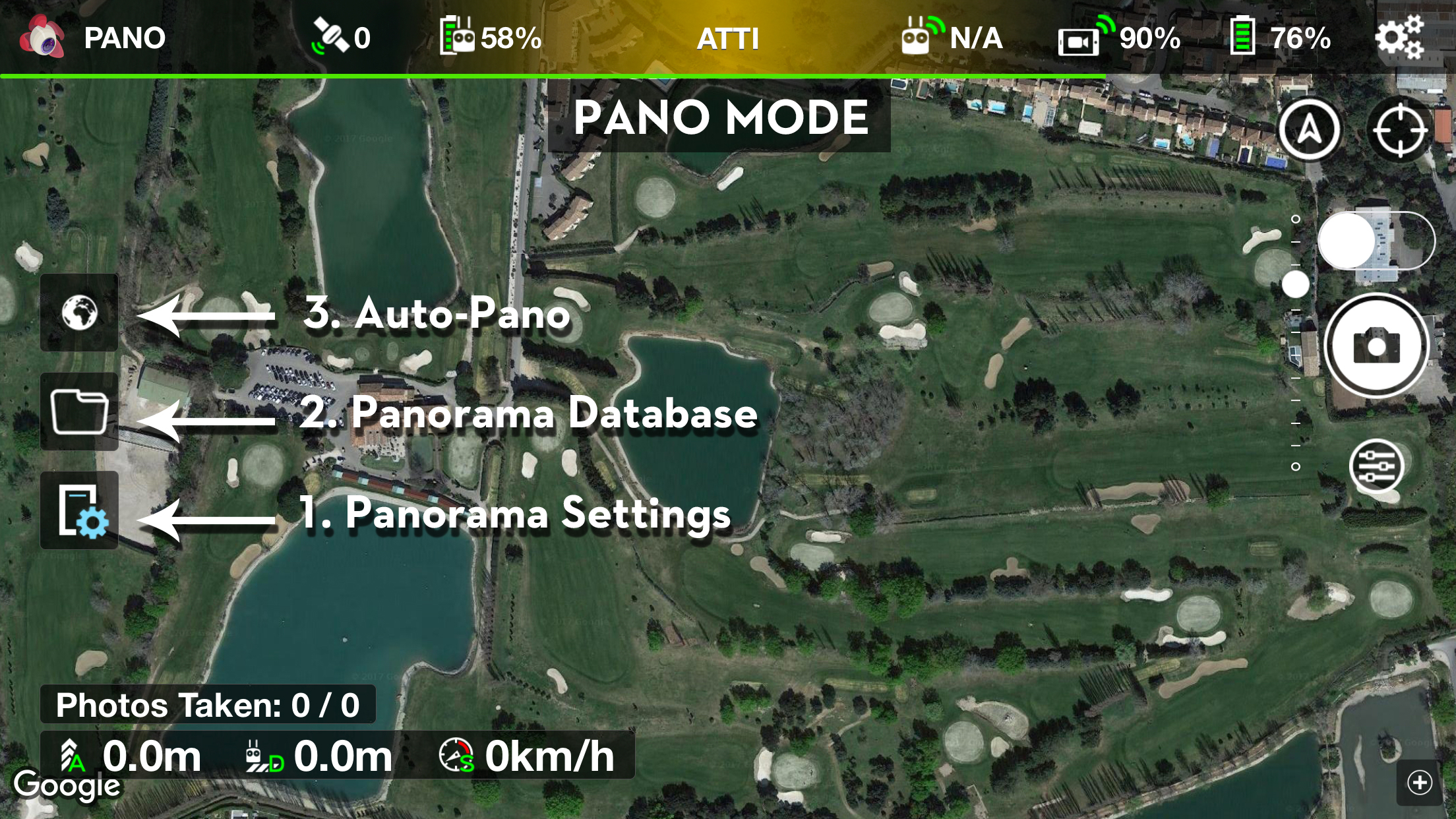
- Panorama Settings: Tap to bring up the Panorama settings window (details below).
- Panorama Database: Tap to show the Panorama Database which lists all your panoramas (iOS only – details below).
- Auto Pano: Tap to start an Auto Pano.
Panorama database (ios only)
The Panorama Database lets you stitch, view and share the panoramas you have shot all within Litchi.
The Panorama Database is not automatically backed up or synced, as such be aware that uninstalling Litchi will also permanently delete the Panorama Database.
After selecting a panorama in the database, select the desired stitching quality and tap on “Create Panorama” to stitch it within Litchi.
Warning Avoid stitching a panorama while the drone is in the air as the stitching process can take a while and uses a lot of resources.
There are 3 available quality settings for stitching:
- Low: Uses the preview images automatically downloaded by Litchi after a panorama is shot. Can be done without downloading the high quality images from the drone but produces a lower quality panorama.
- Medium: Requires downloading the high quality images from the drone to produce a higher quality panorama. Up to 65 megapixels on iPhone and up to 100 megapixels on iPad Pro.
- High: Requires downloading the high quality images from the drone to produce an even higher quality panorama. Up to 130 megapixels on iPhone and up to 220 megapixels on iPad Pro.
Warning
Some older devices may not have the required resources to successfully stitch a panorama. Try lowering the quality setting.
To improve the chances of a successful stitch, please follow these steps:
- Use the Auto Pano feature, which will optimize the camera and panorama settings
- Avoid starting the Panorama shot with the drone facing the sun
Once the panorama is stitched, you will be presented with the below interface:
Pausing a mission
Pausing a mission can be done by tapping on the pause button in the left bar.
Point of interests
When adding a new POI, all waypoints which have no assigned POI will have their heading setting adjusted in order to target the new POI.
To drag a POI, do a long press on the POI, then move it around. This will automatically adjust the heading setting of the waypoints that are currently targetting the POI.
To view the POI settings, tap on the POI.
You will be able to adjust the POI’s altitude which is used for the “Focus POI” waypoint gimbal setting.
To delete a POI, while the POI settings window is displayed, tap on the top left corner trash icon. Deleting a POI will automatically reassign nearest POIs for waypoints which had the now-deleted POI in target.
Regaining control
Whenever the drone flies autonomously, you can regain control instantly at any time using the remote controller’s flight mode switch.
- For newer drone models (Mavic, Phantom 4, Spark, Inspire 2), toggle the flight mode switch from “P” to “S”(sport) mode in order to regain control. You may switch back to “P” mode afterwards.
- For Mavic Mini 1, use the flight mode button in the top bar to switch from “P” to “S”(sport) mode in order to regain control. You may switch back to “P” mode afterwards. In addition, by default the RTH button on the remote controller can be used to pause an autonomous flight.
- For older drone models (Phantom 3, Inspire 1), toggle the flight mode switch from “F” to “P” mode in order to regain control. You may switch back to “F” mode afterwards.
Running a mission
Press the “Play” button located in the left button bar to show the mission preflight report. If the mission is valid, you will be able to tap the “Start” button in the report window to start the mission.
Before starting the mission, you can also select a specific starting waypoint.
Running a track session
Select the object you wish to track on the video preview using the Pinch gesture (with 2 fingers, see image below).
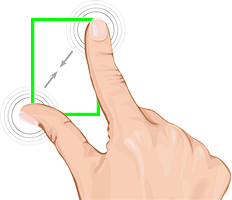
When you are happy with the selection, release your fingers from the screen and Track will automatically start.It is recommended to start Track while the aircraft is airborne.To select a different object, simply start the procedure again.Info To recenter the current selection, double tap where you want the new object center to be on the video preview.
For optimal tracking, ensure the background scene is not too cluttered and that there is enough contrast between the tracked object and its surroundings.
It is also important to select your object carefully.
Settings
Info
Simulator mode
The Simulator mode lets you try the Litchi flight modes without actually flying the drone in the real world. A connection to the drone is however still required.
Simulator mode can be enabled with a long press at the center of the top bar.
The top bar’s background color will change to purple to indicate that the drone is in Simulator mode.
Once enabled, you can fly the drone virtually, the rotors will not spin up when taking off.
Disable Simulator mode using a long press again at the center of the top bar. The drone must then be restarted if you wish to perform a real flight.
Status bar

- Mode Switch Button: Tap to change the flight mode.
- Satellite Count: Shows the number of satellites that the aircraft is
locked onto. - Extender Battery: Shows the remaining Range Extender battery percentage.
- Battery Status: This bar shows the status of the aircraft battery. The part
in red represents the battery required to go home. - Aircraft Status/Connected Button: Shows the current aircraft flight
status. Tap this button to connect to the aircraft when it shows a red
“Disconnected” or to disconnect otherwise. Disconnecting manually can be useful when you want to cache the google maps for offline use. When connecting/disconnecting to/from the aircraft, Wi-Fi will be turned on/off automatically. - Uplink: Shows the strength of the remote controller signal.
- Downlink: Shows the strength of the video downlink signal. Tap to boost the phantom’s video signal.
- Aircraft Battery: Shows the remaining aircraft battery percentage.
- General Settings: Tap to show general settings.
Stitching a panorama outside of litchi
Here is a non-comprehensive list of software you can use to stitch the photos together outside of Litchi:
Stopping a mission
Stopping a mission can be done by switching the RC S1 switch from top position to middle position and then back to top position.
Stopping focus
Stopping a Focus session can be done using the red stop button in the left button bar.
Stopping follow
Stopping orbit
Stopping an Orbit session can be done using the red stop button in the left button bar.
Stopping panorama
Stopping a Panorama shot can be done using the red stop button in the left button bar.
Stopping track
Stopping a Track session can be done using the “Stop Tracking” button in the left button bar.
Track
In Track mode, Litchi uses state of the art computer vision algorithms to track a selected object on the video preview and keep it in the frame.
You have the choice to either fly the aircraft manually while Litchi keeps the object in the frame,
use the Orbit feature to instruct the aircraft to Orbit around the tracked object, or start Follow where the drone will autonomously follow the tracked object.
The aircraft rotation (yaw) and gimbal pitch angle are controlled by Litchi as well as the gimbal yaw for Inspire 1-2.
Enter the Track mode by pressing the Flight Mode icon at the top left of the Litchi screen. Select “Track”.
Warning Because Litchi decodes the video, runs the algorithms to track the object and renders the video, all of this in real-time, a high performance mobile device is required. Be sure to close all background applications and screen recorders before using Track. Video lag will kill tracking.
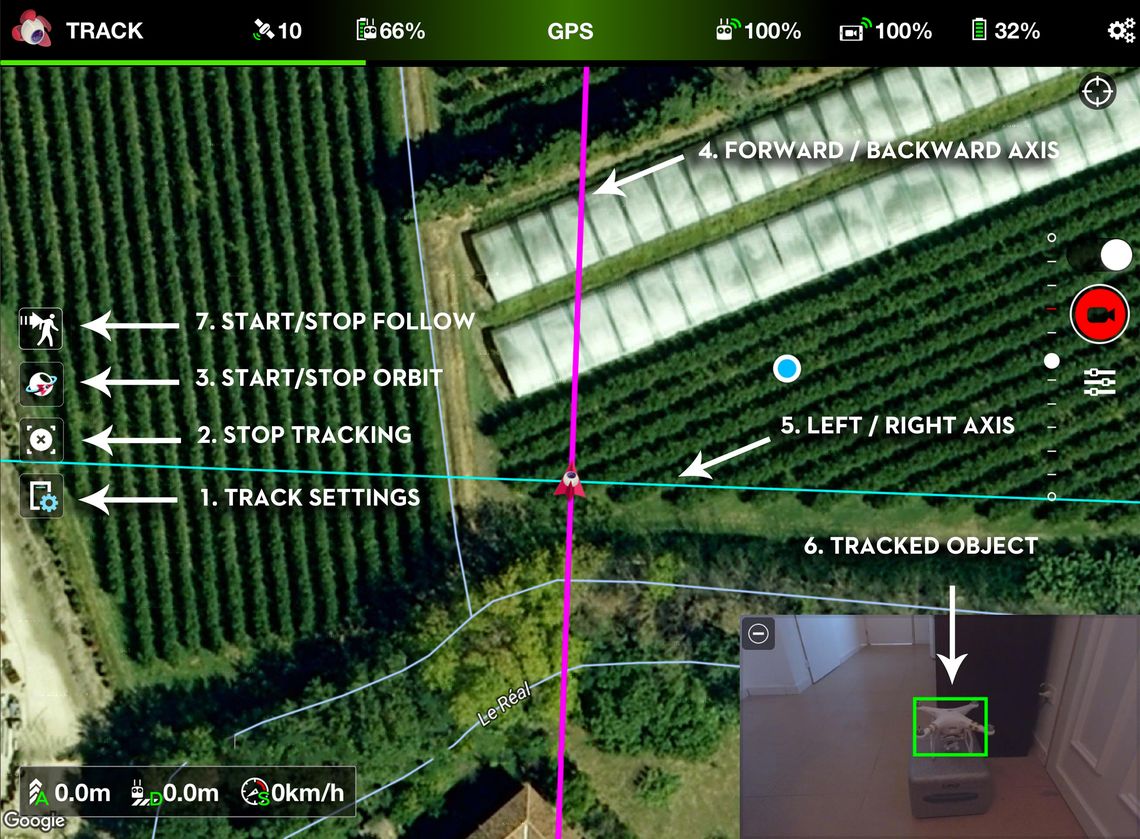
- Track Settings: Tap to bring up the Track settings window (details below).
- Stop Tracking: Tap to stop the current Track session.
- Start/Stop Orbit: Tap to start or stop an autonomous Orbit around the tracked object. The speed at which the aircraft will orbit can be changed in the Track settings.
- Forward/Backward Axis: Represents the “Joystick Reference” pitch axis along which the aircraft course is locked. Shown when “Aircraft Rotation” is enabled and a custom “Joystick Reference” is selected.
- Left/Right Axis: Represents the “Joystick Reference” roll axis along which the aircraft course is locked. Shown when “Aircraft Rotation” is enabled and a custom “Joystick Reference” is selected.
- Tracked Object: A green rectangle around the object means Litchi is confident it is tracking the correct target, an orange rectangle indicates less confidence, a red rectangle indicates a very low confidence.
- Start/Stop Follow: Tap to start or stop an autonomous Follow.
Virtual reality
Available in all flight modes, the VR mode immerses you into a real First Person View, the video stream appears right in front of your eyes.
You also have the ability to control the gimbal by moving your head. VR mode requires a remote controller.
To start VR mode, tap on the goggles icon located the top right corner of the video screen.
The VR mode requires the use of a phone together with external mobile VR goggles. Litchi is compatible with most VR goggles.
Below are some recommendations:
It is highly recommended to get a pair of goggles with a headstrap, not all of them comes with one.
Additionally, if your goggles expose the mobile device camera to the outside, you will be able to take advantage of the mobile device camera toggle in Litchi (except for P3 Standard).
Warning The VR mode brings you into another world, be aware of your surroundings as you will not be able to see your aircraft.
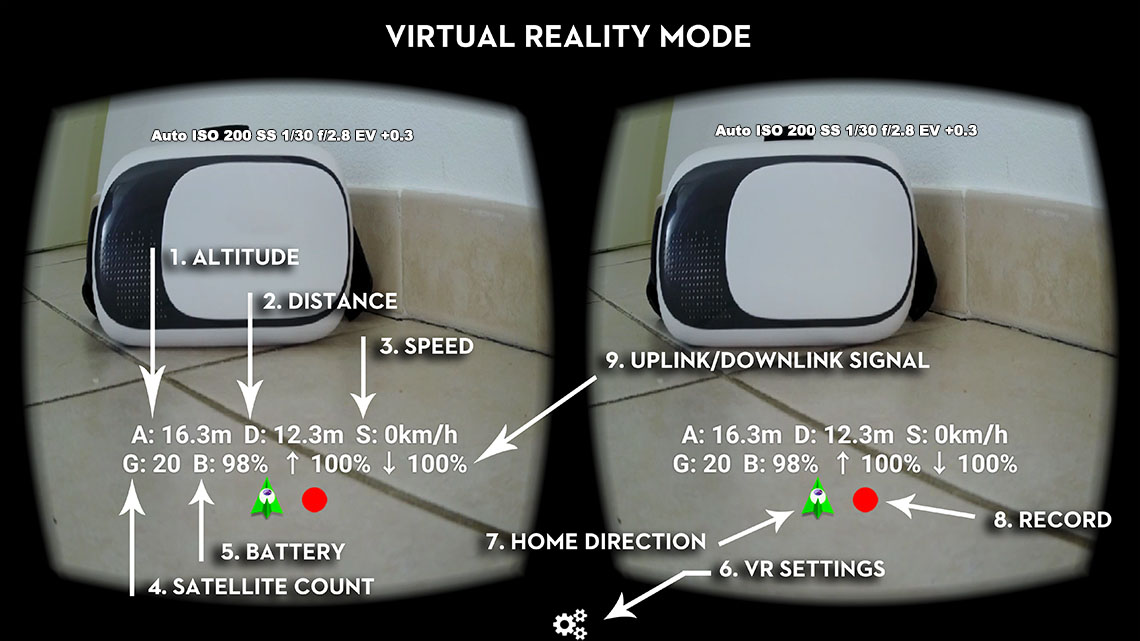
Visual mission planning with google earth
Using Google Earth Pro, you have the ability to plan a waypoint mission in 3 dimensions. This enables you to frame your shots easily and to position the camera exactly where you want it for each waypoint.
You can then import the mission into Mission Hub. To learn more about this planning method, please watch the following tutorial video.
Waypoint
Waypoint mode lets you plan a path made of several waypoints that the drone can then fly autonomously.
Classic waypoint missions can be planned as well as advanced camera moves such as Selfies and Cable Cams.
Enter the Waypoint mode by pressing the Flight Mode icon at the top left of the Litchi screen. Select “Waypoint”. You can then start editing missions.
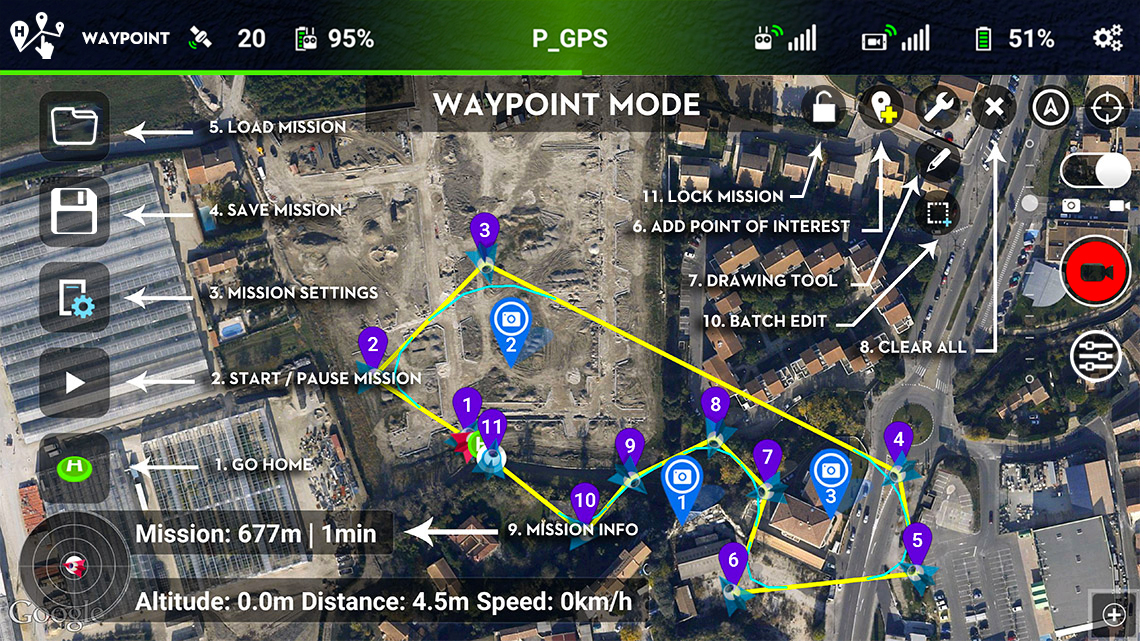
- Go Home: Tap to trigger Return to Home (Android only). Return to Home can also be triggered using the remote controller.
- Start/Pause/Resume Mission: In edit mode, tap this button to show the pre-flight report and then start the mission. While in a mission, this button will allow you to pause and resume the waypoint mission.
- Mission Settings: Tap this button to display the mission settings.
- Save Mission: Tap this button to save a mission.
- Load Mission: Tap this button to load a previously saved mission.
- Add Point of Interest: Toggles the Point of Interest mode. When on, a click on the map will add a Point of Interest.
- Drawing Tool: Toggles the drawing tool. When on, you will be able to draw a path of waypoints on the map.
- Clear All: Tap to reset everything in the editor.
- Mission Info: Shows general mission information. In edit mode, the total distance and time will be shown. During a mission, the “target” waypoint number will be shown, as well as the current state of the aircraft.
- Batch Edit: Tap to enter Batch Edit mode. Allows you to easily edit multiple waypoints at once.
- Lock Mission: Tap to lock/unlock the mission for editing. A mission’s waypoints cannot be edited until the mission is unlocked. By default, missions are locked after they are loaded.
Waypoint actions
Actions are performed when the aircraft arrives at the waypoint. There are six different waypoint actions, three of which accept an additional parameter.
You can add up to 15 different actions for each waypoint.
Important Waypoint actions are ignored when the mission “Path Mode” is “Curved Turns” as the aircraft will not stop at waypoints then.
Waypoint gimbal pitch
Litchi can control the gimbal pitch automatically during the mission, as long as the aircraft is within range of the remote controller.
To specify how the gimbal pitch should be controlled, each waypoint has a Gimbal Pitch setting which can be one of the following:
Waypoint settings
- Altitude: The altitude of the waypoint relative to the elevation of the aircraft where it took off. The waypoint’s altitude is also shown above the waypoint marker on the map.
- Speed: The speed at which the aircraft will travel from this waypoint to the next. By default the aircraft will use the mission’s cruising speed setting, but the cruising speed can be overriden for each waypoint using this setting.
Warning This setting is only in effect when the aircraft is in range of the remote controller. - Curve Size: Defines the size of the curved turn at this waypoint. A bigger size means the aircraft will start the turn earlier while travelling to this waypoint. This setting only applies when the mission setting “Path Mode” is set to “Curved Turns”. It also does not apply to the first and last waypoints as there are no turns at these waypoints.
Info The path of the curve is drawn in turquoise on the map. It will update dynamically as you adjust the curve size setting. - Heading: The direction relative to north in which the aircraft will look at when arriving at this waypoint (0° is North, 90° is East). This setting only applies when the mission setting “Heading Mode” is set to “Waypoint Defined” (“Custom” on iOS). If two consecutive waypoints have different headings, the aircraft will smoothly transition from one heading to the other while travelling from the first waypoint to the second.
Info The waypoint heading is represented by the blue aircraft icon on top of each waypoint. It will update dynamically as you adjust the heading setting. - Rotation: When two consecutive waypoints have different headings, the aircraft will smoothly rotate from the first heading to the next. This setting defines the direction in which the aircraft will rotate, clockwise or anti-clockwise.
- Gimbal Pitch: Choose between “Disabled” where the gimbal pitch control will be manual, “Focus POI” where Litchi will automatically control the gimbal pitch to keep the selected POI in the center of the frame (blue markers), or “Interpolate” where you can specify the gimbal pitch angle at this waypoint. For “Interpolate” to work, the previous or next waypoint need to be set to “Interpolate” as well. Litchi will then automatically adjust the gimbal pitch angle to start and end at the specified angles, and smoothly transition while travelling between the two waypoints.
- POI: Use this setting to change which POI a waypoint will focus on. By default, when adding a waypoint it will focus on the nearest POI, if there is one.
- Photo Capture Interval: Defines the time/distance interval in seconds/meters when two photos are taken as the aircraft moves from this waypoint to the next. The interval can be set between 0 and 100 seconds/meters. The first photo will be taken as the aircraft leaves the current waypoint. If the requested interval exceeds the camera’s capability, the photos will be taken at the maximum possible speed. By default, this setting uses the global ‘Photo Capture Interval’ mission setting’s value.
- Actions: Each waypoint can have up to 15 different actions (more details below).
Waypoints
To add a waypoint, tap anywhere on the map (make sure that the POI toggle is not on). You can add up to 99 waypoints.
To view the waypoint settings, tap the waypoint itself. To drag a waypoint, do a long press on the waypoint, then move it around.
To delete a waypoint, tap the waypoint to open its settings, then tap the minus icon at the top left corner of the waypoint settings window.
To insert a waypoint between two consecutive waypoints, tap the first waypoint of the two to open its settings, then tap the plus icon at the top left corner of the waypoint settings window.
A waypoint will then be inserted between this waypoint and the next, it will be placed exactly in the middle of these two waypoints.
Important The 3D distance between consecutive waypoints must be between 0.6m and 1999m.
Приложения для дронов: litchi
Мы все знаем, что вам нужно официальное приложение DJI GO / DJI GO 4, чтобы летать на наших любимых дронах DJI, верно? Неправильно!
Существует несколько альтернативных приложений, которые могут управлять вашим DJI Mavic Pro, DJI Spark, дроном серии DJI Phantom и другими, лучшее приложение, которое мы встречали – Litchi.
Полное название приложения длинное, но объясняет большую часть того, что оно делает, Litchi для DJI Mavic / Phantom / Inspire / Spark – это надежное приложение, которое мало отличается от приложения DJI, хотя и работает немного иначе.
В нем собрано все лучшее из оригинального приложения DJI, но добавлено несколько новых “плюшек”. Litchi определенно стоит вашего внимания.
Полет по точкам и встроенная поддержка очков VR/FPV – основные факторы, которые привлекают в Litchi.
Скачать Litchi для iOS, Litchi для Android.
Примечания по особенностям работы с приложением litchi
Компания DJI постоянно меняет алгоритм взаимодействия дрона и приложений для его настройки и управления. В связи с этим, возможна ситуация, когда после запуска Litchi, приложение не видит дрон. В ряде случаев помогает предварительный запуск приложения DJI GO 4, и не закрывая его, запустить Litchi.
Мы рекомендуем использовать для работы с приложением Litchi устройства на базе IOS. По нашему опыту Litchi под этой операционной системой работает более устойчиво. Кроме того, в IOS возможно переключаться между разными приложениями для управления дроном налету, в то время как OS Android каждый раз требует смены приложения по умолчанию для пульта, как для USB устройства.

